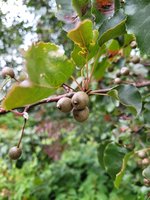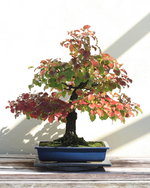You are using an out of date browser. It may not display this or other websites correctly.
You should upgrade or use an alternative browser.
You should upgrade or use an alternative browser.
Tree ID?
- Thread starter coltranem
- Start date
dancing with butterflies
Yamadori
- Messages
- 96
- Reaction score
- 33
Maybe a guva or a kiwi oh wait kiwis fruit on vines not trees
Dav4
Drop Branch Murphy
- Messages
- 13,107
- Reaction score
- 30,170
- USDA Zone
- 6a
I recently moved to a property in zone 6a MI and have a tree with identical leaves and fruit in the landscape. Based on the flowers, I'm 90% + sure it's a crab.
coltranem
Chumono
This is at a local park in Massachusetts
Totally agree Bradford Pear.This looks a Bradford pear or an offspring of one...
(Pyrus calleryana)
ShadyStump
Imperial Masterpiece
I'm in the pear camp, but uncertain about the variety.
In my town they have the entire downtown business (read "tourist) district on Main Street lined with these.
In my town they have the entire downtown business (read "tourist) district on Main Street lined with these.
penumbra
Imperial Masterpiece
It is a Callery pear for sure. I have seen many hundreds of these growing wild and thousands of fruit.
Dav4
Drop Branch Murphy
- Messages
- 13,107
- Reaction score
- 30,170
- USDA Zone
- 6a
I learned something today…
Paradox
Imperial Masterpiece
Then it was a good dayI learned something today…
Shibui
Imperial Masterpiece
I'm a bit late but agree with Pyrus calleryana.
Some of the landscape flowering pears are P. calleryana but it is also used as rootstock for fruiting pears so some old house sites have these where the fruit trees have died but the stock has kept growing. They also naturalize round here when birds spread the seeds.
Some of the landscape flowering pears are P. calleryana but it is also used as rootstock for fruiting pears so some old house sites have these where the fruit trees have died but the stock has kept growing. They also naturalize round here when birds spread the seeds.
rockm
Spuds Moyogi
Bradford pear (pyrus calleryana). Extremely common, invasive species. Can make decent bonsai if the trunk is worth the effort. Pretty easy to dig up and pretty tough. Can tolerate extreme root reduction at collection. Best collected in the spring. The Bradford Pear below is at the National Bonsai and Penjing Museum in D.C.
Attachments
Javaman4373
Shohin
Does the Bradford pear have significant thorns? I have a tree that looks like this in the landscape, similar looking fruit and it has thorns on small twigs and I thought it was some type of thorn apple.
Last edited:
penumbra
Imperial Masterpiece
Bradford does not normally have thorns but occasionally it does have a few that are modified fruiting spurs. The wild seedlings from Bradford pears, cannot be called Bradford and are calleryana, as are the seedlings of other Calleryana cultivars like Aristocrat, Cleveland Select, Capital, and Chanticleer. These wild seedlings are much more apt to produce thorns. Thus is also true of the Genus Malus and other trees that develop poms.Does the Bradford pear have significant thorns?
orangeyeoman
Yamadori
Interesting. I have two trees the city (NYC) has labeled as callery pears in front of my house, but they've never had fruit like this in the 7 years I've been in the house. But who knows what NYC street life does to trees . . .It is a Callery pear for sure. I have seen many hundreds of these growing wild and thousands of fruit.
ShadyStump
Imperial Masterpiece
Around here we often have late spring frosts that will kill the blossoms or young fruit. If your climate is prone to frosts after early April, it's possible it's the same problem.Interesting. I have two trees the city (NYC) has labeled as callery pears in front of my house, but they've never had fruit like this in the 7 years I've been in the house. But who knows what NYC street life does to trees . . .
It could also be tree care. If the soil is depleted or compacted they may just not have the wherewithal to bloom. Had this problem with the lilacs when I first moved into this house a year ago. Heavy clay soil under a xeriscaped yard that'd routinely been sprayed with herbicide for years. No healthy blossoms at all in spring, but I watered and fertilized this summer, and pulled the weeds in the rocks by hand, and they're looking allot better now.
orangeyeoman
Yamadori
The soil is most assuredly depleted, and compacted. NYC street trees lead a hard life. Though the trees seem otherwise healthy, and grow like gangbusters. They're close to 40' tall, and I have to (discretely, as the city forbids it) trim their branches back about 3'-4' twice a year to keep them from scraping my house.Around here we often have late spring frosts that will kill the blossoms or young fruit. If your climate is prone to frosts after early April, it's possible it's the same problem.
It could also be tree care. If the soil is depleted or compacted they may just not have the wherewithal to bloom. Had this problem with the lilacs when I first moved into this house a year ago. Heavy clay soil under a xeriscaped yard that'd routinely been sprayed with herbicide for years. No healthy blossoms at all in spring, but I watered and fertilized this summer, and pulled the weeds in the rocks by hand, and they're looking allot better now.
Similar threads
- Replies
- 10
- Views
- 340



